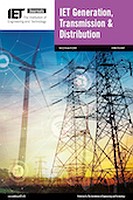|
Autors/es
Rolán, A. ; Giménez, P.; Yagüe, S. J. ; Giménez, P.; Yagüe, S. J. ; Bogarra, S.; Saura, J.; Bakkar, M. ; Bogarra, S.; Saura, J.; Bakkar, M.
|
Abstract
Faults in power systems cause voltage sags, which, in turn, provoke large current peaks in grid-connected equipment. Then, a complete knowledge of the inverter behaviour is needed to meet fault ride-through capability. The aim of this study is to propose a mathematical model that describes the behaviour of the currents that a three-phase inverter with RL filter injects to a faulty grid with symmetrical and unsymmetrical voltage sags. The voltage recovery process is considered, i.e. the fault is assumed to be cleared in the successive zero-cross instants of the fault current. It gives rise to a voltage recovery in different steps (discrete voltage sag), which differs from the usual model in the literature, where the voltage recovers instantaneously (abrupt voltage sag). The analytical model shows that the fault-clearing process has a strong influence on the injected currents. Different sag durations and depths have also been considered, showing that there exist critical values for these magnitudes, which provoke the highest current peaks. The analytical study is validated through simulations in MATLABTM and through experimental results.
|

WoS
Scopus
Altmetrics
  
|
|
Publicació
IET Generation Transmission & Distribution, 2019, vol. 13, no. 3, p. 435-443
|
